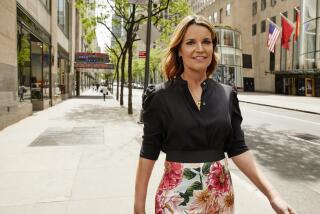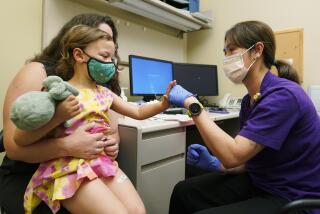Her own leap of faith
THE baby’s chest was heaving as he gasped, struggling mightily for each breath. Two months old, he lay splayed on the bed in the neonatal intensive-care unit, the tubing and wires to his IV and monitors forming a spider web of filaments around his tiny body. His respirations were becoming more labored by the minute; we would soon be adding a ventilator to his bedside.
In my first night on hospital duty as a pediatric intern, I had hoped for a gentle transition into the role as soldier against disease and death. Instead, I had been thrown into the proverbial river without a life preserver -- to learn how to be a life preserver.
With the heady confidence of young adulthood, I had long since relegated my faith to a dusty shelf, but I found myself jokingly asking the “man upstairs” for a little bit of luck through the night for us all.
Under the supervision of the pediatric resident, I inserted a breathing tube into the baby’s tiny throat and guided it down the windpipe. His color improved with the assisted ventilation and oxygen, and his condition stabilized enough for us to try to determine the cause of his distress. The baby’s parents, a young couple no older than me, insisted that he had been fine until the last week, when he had developed “a slight cold.” The chest X-ray gave us our likely answer. Instead of the pneumonia we had feared, we saw that the young patient had a severely enlarged heart, the cardiac muscle thinned and weakened so that it was unable to pump blood and oxygen effectively. A diuretic relieved some of the resulting fluid in the chest, but medicines to strengthen the affected muscle were ineffective. The baby continued to worsen through the night.
Our pediatric cardiology consultant advised us that, barring a spontaneous recovery of the heart muscle or a heart transplant, both essentially impossible in that era and within that timeframe, the infant’s prognosis was extremely poor. Trembling, I gently tried to inform the boy’s parents of the gravity of his condition. They responded with a sober maturity, reaching tearfully for each other and their son. I did not dare allow myself to share their tears.
After a few moments, the parents turned to me and asked for my hand. Uncertain, I extended my fingers to touch the mother’s. “Please pray with us” was the request, and, following their suit, I bowed my head. Their moving prayers sought God’s help in curing the boy and pledged their acceptance of his decision.
Neither my resentful tenure in Sunday school as a teen nor my secular scientific training in college and medical school had provided me with guidelines for how to respond to the beliefs of my patients and their families. Though I no longer paid credence to a God who, actively or passively, allowed the suffering of so many innocents, I could not deny the comforting role that faith played in the lives of those I sought to help. Science demanded that I give the parents the observable facts about their son’s condition -- but humanity demanded that I support their means of solace and hope.
I stayed by the baby’s bedside through the night, listening to the parents’ prayers and helping soothe their tears. Their child passed away before dawn, a victim of an aggressive and untreatable viral infection that had caused myocarditis, destructive inflammation of the heart muscle. Neither the prayers nor the medical care available in the late ‘70s could save the boy’s life.
Today, scientific research and experimentation have increased the chances of survival and reduced the risks of permanent heart failure in patients with myocarditis. Echocardiography, immunosuppressive medications, drugs that improve cardiac and circulatory function, pacemakers and heart transplants all can improve the prognosis for this rare condition.
And what about prayer -- can it play any role in our patients’ prognoses? Research has shown that those who actively practice a religion may see some personal health benefits, perhaps because of social support and reduced risk factors for poor health due to religiously guided lifestyle choices. A study in the April 9 issue of the Archives of Internal Medicine explored the relationship between a doctor’s own religious and spiritual perspective and his or her perception of religion’s influence on health. A majority of the doctors surveyed believed that religion and spirituality do have a positive effect on health, but more as a source of hope, consolation and support rather than as a pragmatic medical “cure.” Unsurprisingly, the more religious physicians were most likely to ascribe significant health benefits to devout patients from the practice of their faith.
In my own experience, I have witnessed prayer to be a gift of comfort for my religious patients and families, especially when they are facing critical illness and death. Though I practice only scientific medicine, I feel a strong obligation to support, and occasionally participate in, the expressions of faith in the manner and form my patients and their families request -- for their sake.
In the last month of my internship, I was called to the maternity ward to do a routine clearance of a newborn for discharge from the hospital. I was surprised to see the parents who had suffered such a tragic loss only 11 months before. God had answered their prayers, they averred, and they were blessed with a new son. I was pleased to confirm the boy seemed healthy, and I was happy to once again hold hands with the couple as they expressed gratitude to God for the resurrection of their family.
*
Dr. Linda Reid Chassiakos is director of the Klotz Student Health Center at Cal State Northridge and a clinical assistant professor of pediatrics at UCLA.
More to Read
Sign up for Essential California
The most important California stories and recommendations in your inbox every morning.
You may occasionally receive promotional content from the Los Angeles Times.










